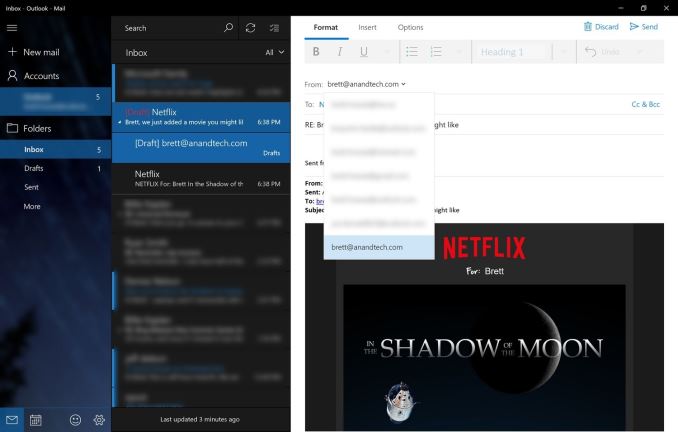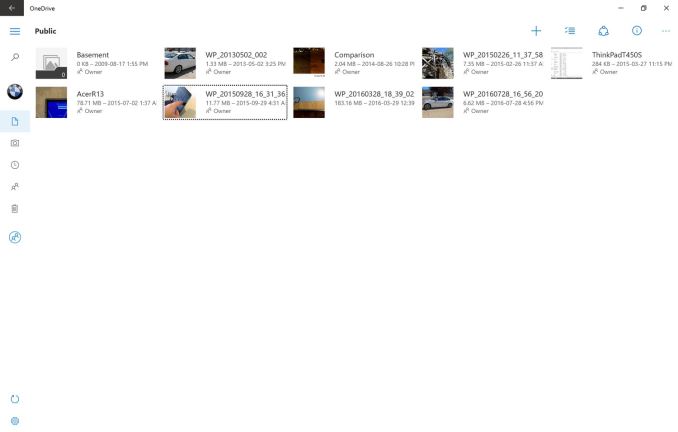Windows 10 Anniversary Update: The Road To Redstone
by Brett Howse on August 2, 2016 8:00 AM EST- Posted in
- Operating Systems
- Microsoft
- Windows 10
New Features And Built-In App Updates
Dark Mode
The Anniversary Update also adds another feature to personalize the experience: Dark Mode. As the name suggests, Dark Mode changes the default color scheme to black. The built-in apps also set their color scheme based on this setting, including mail, the store, and more.
This is certainly a nice feature for personalization, but it’s also a smart idea with recent launches of PCs and tablets with OLED displays. Lenovo showed off their own theme for Windows 10 at CES, for use with their OLED laptops, which eliminates a lot of the bright white display aspects that desktops and laptops have become accustomed to.
Other apps, such as Edge, also include a dark mode but the toggle is in the app settings, so you can customize this the way you prefer.
Mail App
The built-in Mail app hasn’t changed much visually since it was launched, but it’s continued to gain features which were very much missing when the OS first shipped. For instance, the mail client originally shipped with Conversation View as the only way to see your mail. About a month after Windows 10 shipped, an update arrived which allowed you to set the view to the more traditional view of chronological order.
With the Anniversary Update, Microsoft has finally fixed another missing feature which was a huge inconvenience for many people (myself included) which is you can finally send mail as another address. The Windows 8.1 mail client supports this, Microsoft’s Outlook.com supports this, but until this update, the Windows 10 mail client was missing this. You could of course put multiple accounts into it, but if you’ve consolidated to one, you can now use a drop-down selection on the send address to pick any addresses configured.
OneDrive
The OneDrive experience changed dramatically with Windows 10. Windows 8.1 featured the ability to see all of your files in OneDrive, and only download those that you wanted to access. Windows 10 ditched that and went with a per-folder sync when OneDrive was configured. With the limited storage on many devices, this wasn’t always ideal. To compound matters, there was no app for OneDrive when the OS launched.
At least one of these issues is now gone, and while not tied to the Anniversary Update, there is now an app to access OneDrive. It does give access, and you can download files that you need, although it’s a traditional file-save dialog rather than just download it and keep the file in sync within the OneDrive folder like in Windows 8.1.
There were reports of placeholders coming back to Windows 10, but at least so far, there hasn’t been any official word of this feature coming back. Until a new solution is found, OneDrive is not be the integrated experience it was in Windows 8.1.













194 Comments
View All Comments
jlabelle2 - Wednesday, August 17, 2016 - link
- Wait so now Cortana only uses Edge and Bing?As much as Google Now on Android only use Google, and Siri is only using Safari and...
Gurdas - Tuesday, August 2, 2016 - link
For those who can't wait, here's how to get the update right away:https://blogs.windows.com/windowsexperience/2016/0...
SteelRing - Tuesday, August 2, 2016 - link
Please, someone, come up with something to strangle and kill Cortana. I just knew it they gonna force it down your throat once they reeled everyone to upgrade to Win10. So glad I didnt do any of my Win7 machines.Michael Bay - Tuesday, August 2, 2016 - link
Nobody`s forcing you to use it. First thing I did after installing 10 was killing the icon and fogetting it existed.Freakie - Tuesday, August 2, 2016 - link
Looks like we might be limited to just blocking it in our firewalls. I have Cortana and Telemetry disabled in both Group Policy and the IP's blocked in my firewall. I always have my firewall set to ask me what to do when it encounters a connection that I haven't created an Allow or Deny rule for. With that, I've caught a few more phone-home's that I've been able to disable.To be honest I'm just waiting for the actual Windows Server 2016 to be released. Having a .edu email, I get it free through DreamSpark and the Server edition at least keeps the ability to disable all that crap. And I don't mind the slightly more complicated setup.
Notmyusualid - Wednesday, August 3, 2016 - link
THIS - is on my mind.Win Server on my machine. That way I have complete control.
But alas, I've not a new'ish versions' product key laying around, and I cannot be bothered with 90-day trials.
MANLEY7878 - Tuesday, August 2, 2016 - link
Still waiting.Penti - Tuesday, August 2, 2016 - link
About Centennial, I'm pretty sure you don't actually convert the application to UWP but packages the Win32 app in an AppX package with sandboxing handled by a variant of App-V. So it's still a MFC application if you "convert" that, and a WPF application is still a WPF application too and so on. You currently only have access to a small subset of the UWP API's for your "converted apps". So it's mostly a sandboxed Win32-package with lot's of limitations, that you can sell in the store.Brett Howse - Tuesday, August 2, 2016 - link
It's an AppX running in a sandbox, and yes it has a smaller subset of APIs available, but there's still a lot of APIs that do work with converted apps:https://msdn.microsoft.com/en-us/windows/uwp/porti...
Gigaplex - Wednesday, August 3, 2016 - link
Point is, it's still not UWP.